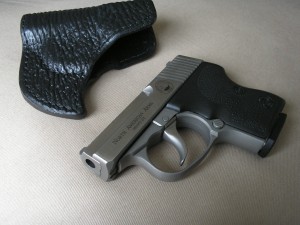There are a lot of firearms owners out who treat their weapons far too casually, who then make lame excuses when they also make potentially life-threatening mistakes. Such dangerous, reckless, or simply indifferent gun owners have informed me, quite incorrectly, that making a distinction between an Accidental Discharge (AD) and a Negligent Discharge (ND) is just “semantics.”
Now, for the record, when people shriek, “Semantics! Semantics!” most of the time this is because they’re too stupid to grasp a critical difference they refuse (willfully or ignorantly) to recognize. Words mean things, and the difference is this case is far from just semantic trifling. In this case, the distinction made between an AD and an ND is the difference between treating a firearm recklessly, and taking responsibility for control of a potentially lethal tool.

An AD, an Accidental Discharge, occurs when your weapon fails mechanically. You didn’t pull the trigger, but the gun went off — perhaps because something got jammed in the trigger guard, or because the gun was defective (my father once bought a Grendel P10 that went off when he chambered a round — that one went back to the factory). Sometimes circumstances conspire to cause an impact to the weapon — it is dropped, or something strikes it, and it goes off. These are accidents. They are things that happen because sometimes, things just do. In these cases, there is nothing the operator could have done before the fact (unless he or she had prescient knowledge of the accident itself) to prevent the shot.
An ND, by contrast, is a NEGLIGENT DISCHARGE. A negligent discharge occurs when the firearm operator fails to follow proper procedure. Some aspect of prudent gun handling is neglected and the gun goes off.
A negligent discharge is always the result of pulling the trigger on a gun when you shouldn’t. If, for example, you hand an empty gun to someone, theyplay around with it, and they hand it back to you, proper gun handling says you check it again when it is returned to your possession. You rack the slide or open the cylinder, you check the chamber visually and by feel if necessary, and only when you are satisfied that you have personally verified the weapon’s unloaded condition do you drop the hammer or striker (by pulling the trigger, natch) for any reason.
If you pull the trigger and put a round through the floor, a wall, or a neighbor, you cannot claim, in this example, “Well, somebody else handled the gun, so it’s not my fault that I didn’t know the gun was loaded.” Your job is to check that weapon, keep it pointed in a safe direction at all times, and never pull the trigger unless you’re certain of the gun’s condition. That’s safe and prudent firearms handling. There’s no excuse for doing it wrong.
Too many gun owners fail to make this important distinction. Any time their guns go off when those weapons shouldn’t, these casual users call it an “accident.” But if you pulled that trigger, it’s not an accident at all — it’s negligence. It’s an act of stupidity with a firearm and we must recognize this fact.
I was taught to treat firearms ritually, and methodically so. This is the only way to approach operation of a deadly weapon. Those who forget this do so at the peril of themselves and those around them.
I was demonstrating the safety on my Beretta NEOS to my mother, when I discovered that the safety was not working. The gun was pointed downrange, of course. I suppose this would be an accidental negligent discharge.
I had a 1911. New, passed all the function checks, looked good. At the range, pointed down range, I put in a loaded magazine and dropped the slide. BOOM! The hammer followed and struck with enough energy to detonate the primer.
I stood there for a moment. Looked at my finger along the frame, not in the trigger guard. Looked at the pistol. Thought about what had just happened. Unloaded the gun. Thought about it some more.
Gun unloaded still passed all function checks. With dummy ammo, hammer followed the slide about half the time. I had the hammer and sear replaced and still have the firearm. That was an “AD”.
I was following all the rules, and so there were no negative outcomes, the round went into the berm. It is my contention that if you look at Col. Cooper’s 4 rules, you have break 2 of them, at least, to have an injury resulting from negligence. Usually when you hear about what the press calls an “accidental shooting”, all 4 rules were broken at the same time.
Bought an SKS at a gun show about 10 years ago, and my first shot at the range was an AD. I released the charging lever, with the rifle pointed downrange, and BOOM! “Slam fire.” Tried it again, under the same conditions — pointed downrange (and BTW, alone at the range), nothing but air near the trigger, and, same result. Took that beast to the next gun show, talked to a dealer about the problem, and traded it to a dealer for a Chinese air rifle. Good lesson — never chamber a round with any firearm pointed anywhere but a safe direction.